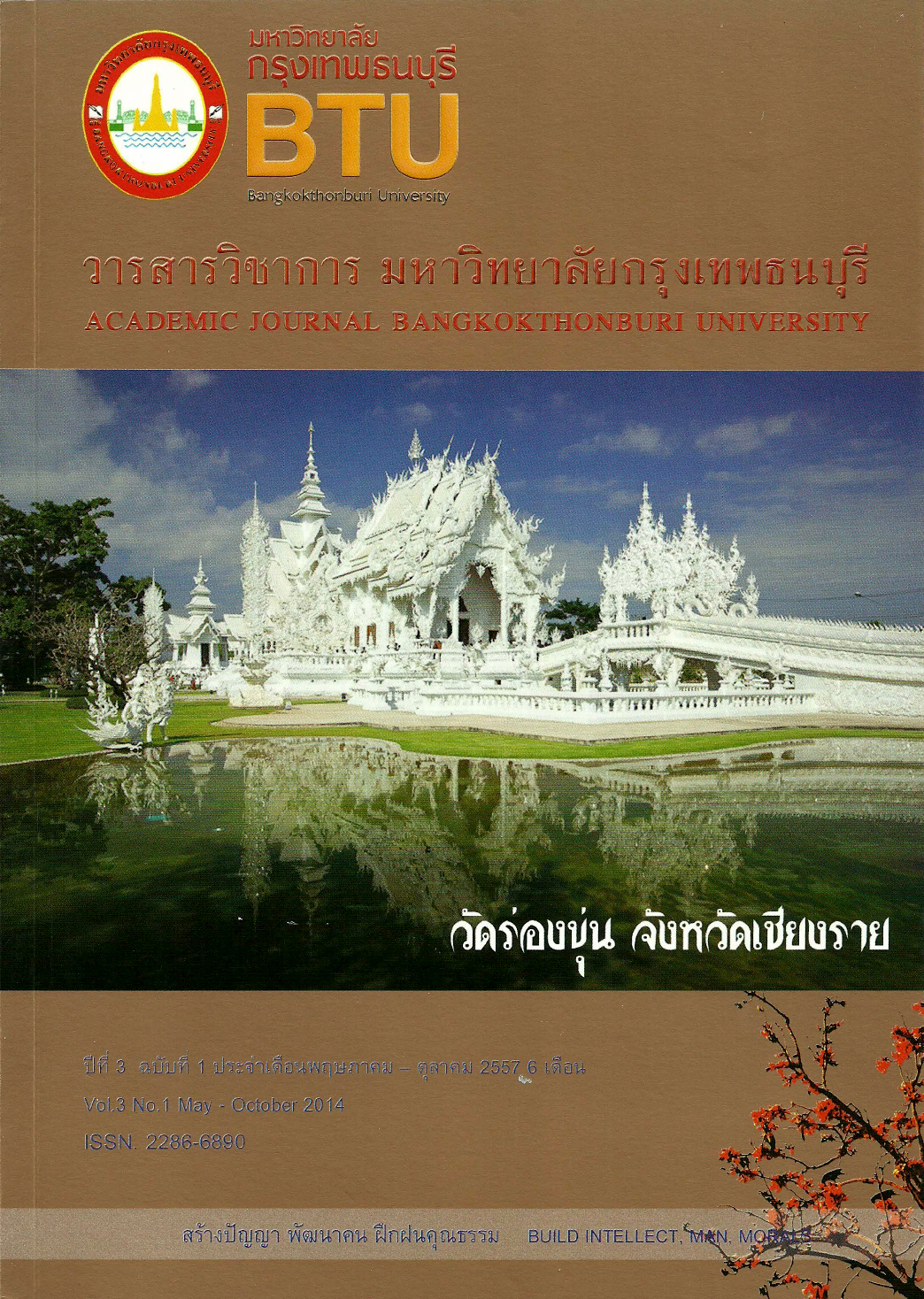The Instructional Model Development by Using Mind Mapping to Develop Learning Achievement of Matthayomsuksa 1 Students
Main Article Content
Abstract
การวิจัยครั้งนี้มีวัตถุประสงค์เพื่อพัฒนารูปแบบการสอนโดยใช้แผนผังความคิดเพื่อส่งเสริม ผลสัมฤทธิ์ทางการเรียนของนักเรียนชั้นมัธยมศึกษาปีที่ 1 และเปรียบเทียบผลสัมฤทธิ์ทางการเรียน ของนักเรียนชั้นมัธยมศึกษาปีที่ 1 ก่อนและหลังการใช้รูปแบบการสอนโดยใช้แผนผังความคิด การ ดำเนินการวิจัยแบ่งเป็น 5 ขั้น คือ 1) การศึกษาข้อมูลพื้นฐาน 2) การพัฒนารูปแบบการสอน 3) การ สร้างเครื่องในการวิจัย 4) การทดลองใช้รูปแบบการสอน 5) การประเมินรูปแบบการสอน กลุ่ม ตัวอย่าง คือ นักเรียนชั้นมัธยมศึกษาปีที่ 1 โรงเรียนศึกษานารี ปีการศึกษา 2555 จำนวน 1 ห้องเรียน จำนวน 40 คน เครื่องมือที่ใช้ในการวิจัยประกอบด้วย 1) แผนการจัดการเรียนรู้ 2) แบบทดสอบวัดผล สัมฤทธิ์ทางการเรียนวิชาห้องสมุดวิเคราะห์ข้อมูลโดยใช้สถิติค่าเฉลี่ย ส่วนเบี่ยงเบนมาตรฐานและ ค่าสถิติ t-test for dependentsample
ผลการวิจัยพบว่า
1. ผลการวิจัยครั้งนี้ทำให้ได้รูปแบบการสอนโดยใช้แผนผังความคิดเพื่อพัฒนาผลสัมฤทธิ์ ทางการเรียนของนักเรียนชั้นมัธยมศึกษาปีที่ 1 ประกอบด้วย 1) หลักการ/แนวคิดของรูปแบบมุ่งให้ผู้เรียน เกิดการเรียนรู้อย่างมีความหมาย โดยอาศัยความรู้เดิมเป็นพื้นฐานเชื่อมโยงไปสู่ความรู้ใหม่ด้วยการ ใช้กระบวนการคิดและการมีปฏิสัมพันธ์กับเพื่อน และเมื่อเกิดความเข้าใจของตนเองแล้วสรุปความรู้ ในเรื่องที่เรียนเป็นแผนผังความคิด 2) จุดมุ่งหมายของรูปแบบการสอน มุ่งพัฒนาให้ผู้เรียนเกิดการเรียนรู้ อย่างมีความหมาย สร้างองค์ความรู้ด้วยตนเอง ใช้กระบวนการคิดในลักษณะต่างๆ จนกระทั่งสามารถ สรุปความรู้เป็นของตนเองได้ และเกิดการเรียนรู้อย่างยั่งยืน 3) กระบวนการเรียนการสอนของรูปแบบ มี 4 ขั้นตอน ดังนี้ ขั้นที่ 1 ขั้นนำเข้าสู่บทเรียน ขั้นที่ 2 ขั้นสอน ขั้นที่ 3 ขั้นสรุป ขั้นที่ 4 ขั้นประเมินผล
2. ผลสัมฤทธิ์ทางการเรียนวิชาห้องสมุดของนักเรียนชั้นมัธยมศึกษาปีที่ 1 โดยใช้รูปแบบการสอน โดยใช้แผนผังความคิดมีผลสัมฤทธิ์ทางการเรียนหลังเรียนสูงกว่าก่อนเรียนอย่างมีนัยสำคัญทางสถิติ ที่ระดับ .01
The Instructional Model Development by Using Mind Mapping to Develop Learning Achievement of Matthayomsuksa 1 Students
The research aimed to develop the instructional model by using mind mapping to develop learning achievement of Matthayomsuksa 1 students and to compare Matthayomsuksa 1 students’ learning achievements before and after the implementation of the instructional model by using mind mapping. The 5 steps of research methodology were; 1) the foundation studying, 2) the instructional model development, 3) the research instrument construction, 4) the instructional model implementation, 5) the instructional model evaluation. The sample used in this research was 40 Mattayomsuksa 1 students of Suksanari school of the academic year 2012. The research instruments were lesson plans, and the library subject learning achievement tests. The data were analyzed by using the mean (), standard deviation (S.D.) and a t-test for dependent sample.
The findings revealed the following facts :
1. The instructional model by using mind mapping to develop learning achievement of Matthayomsuksa 1 students consisted of 1) model rational/approach aims to learn with meaning by using background knowledge related to the new knowledge with thinking process and group interactive. Also, after self-understanding, they were able to summary the knowledge by using mind mapping; 2) the instructional model objectives were to develop the learners’ learning with meaning, constructing knowledge, thinking process, summary the knowledge, and sustainable learning; and 3) 4 steps of learning process were introduction, teaching, summary, and evaluation.
2. The students’ learning achievements on the library subject after learning by instructional model by using mind mapping to develop learning achievement of Matthayomsuksa 1 students was higher than before the instructional model implementation; the difference was statistically significant at the .01 level.


